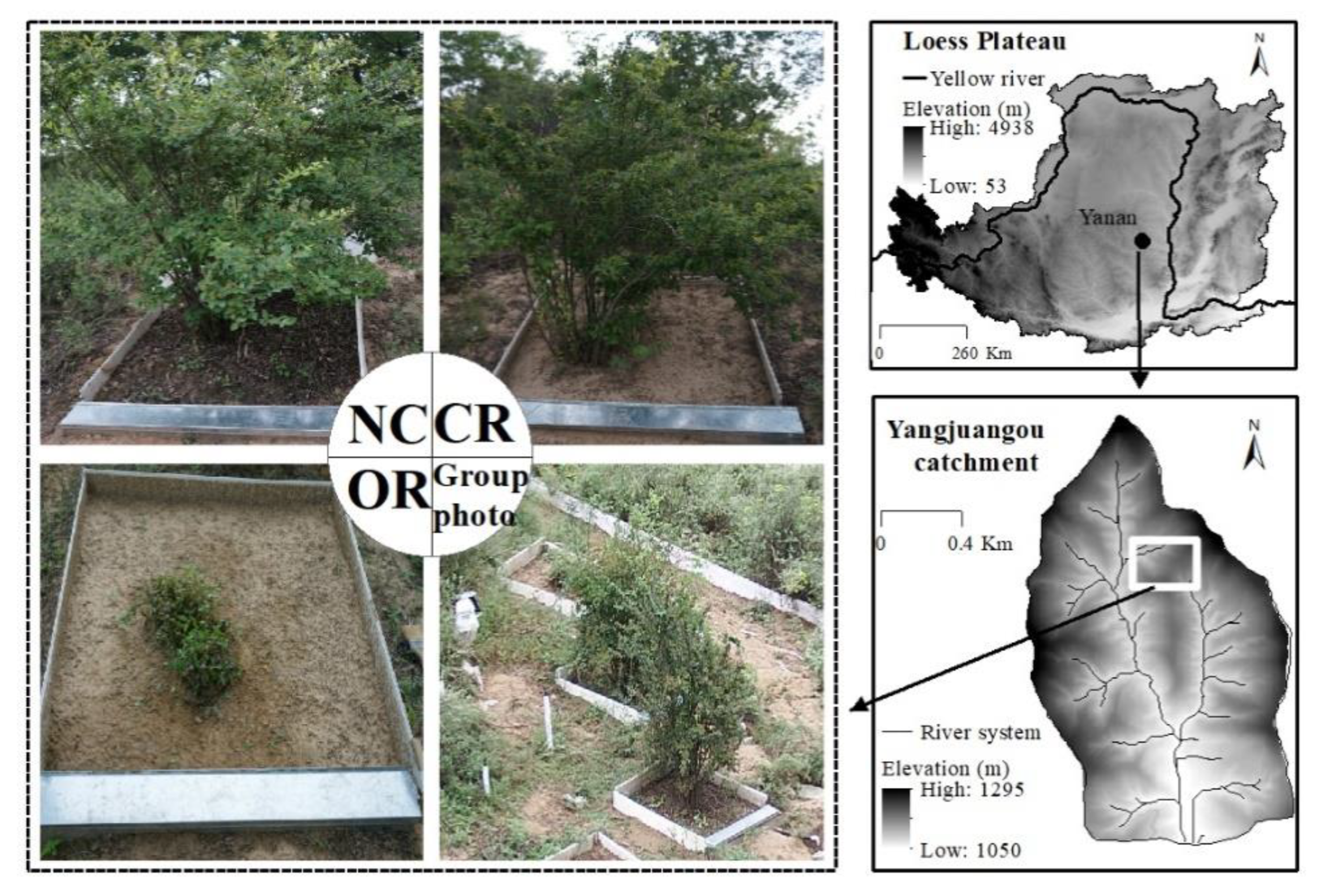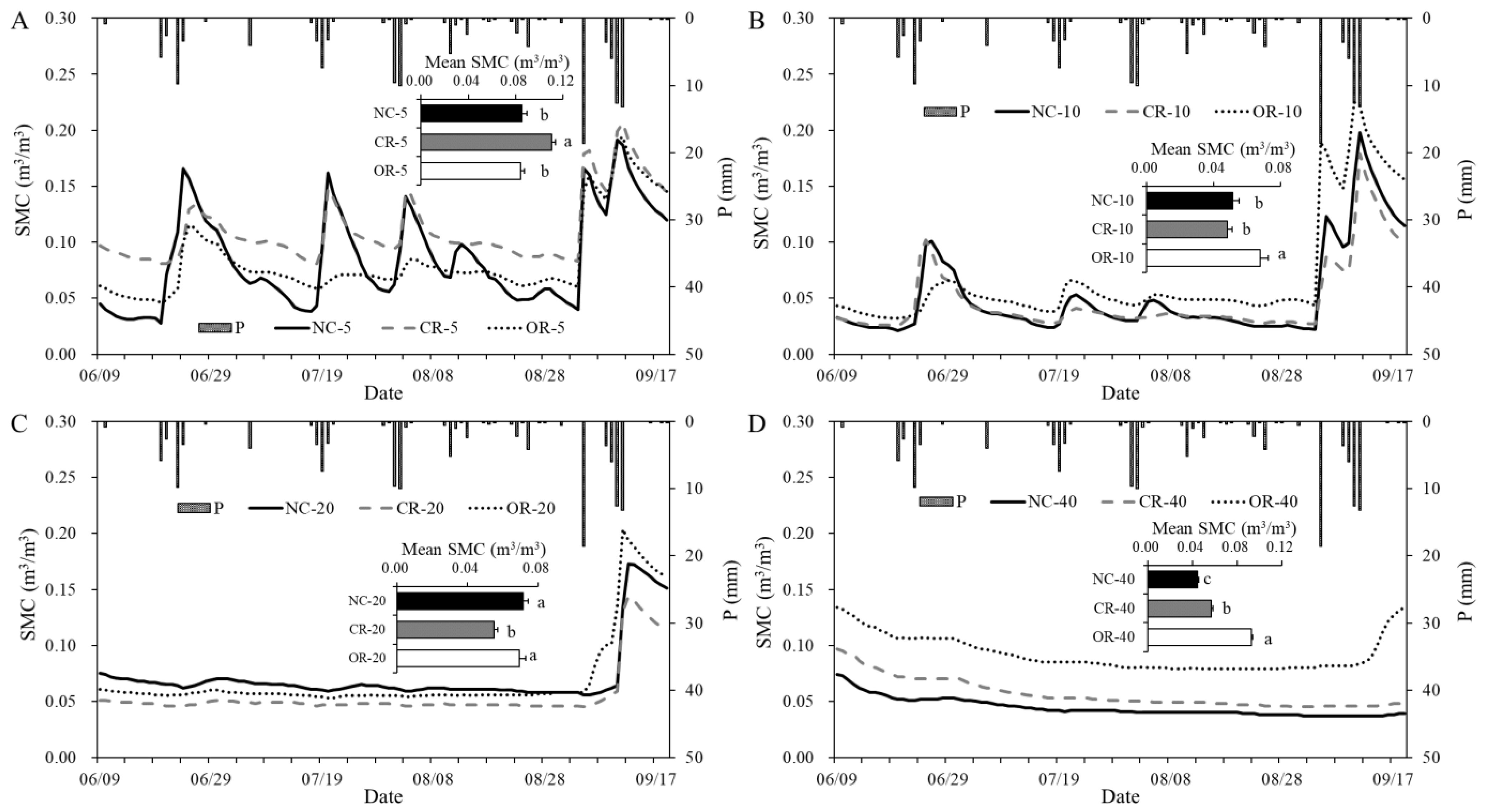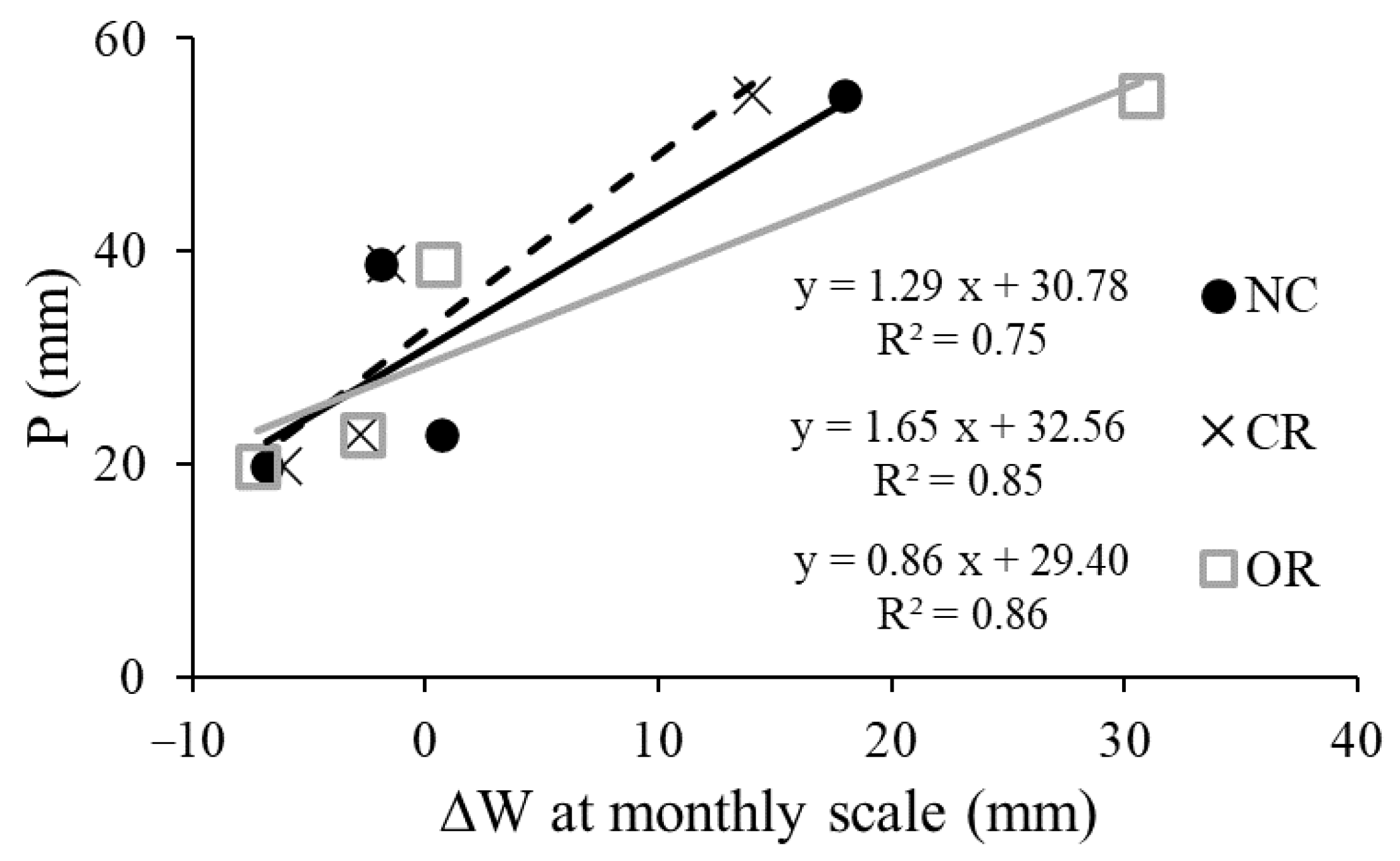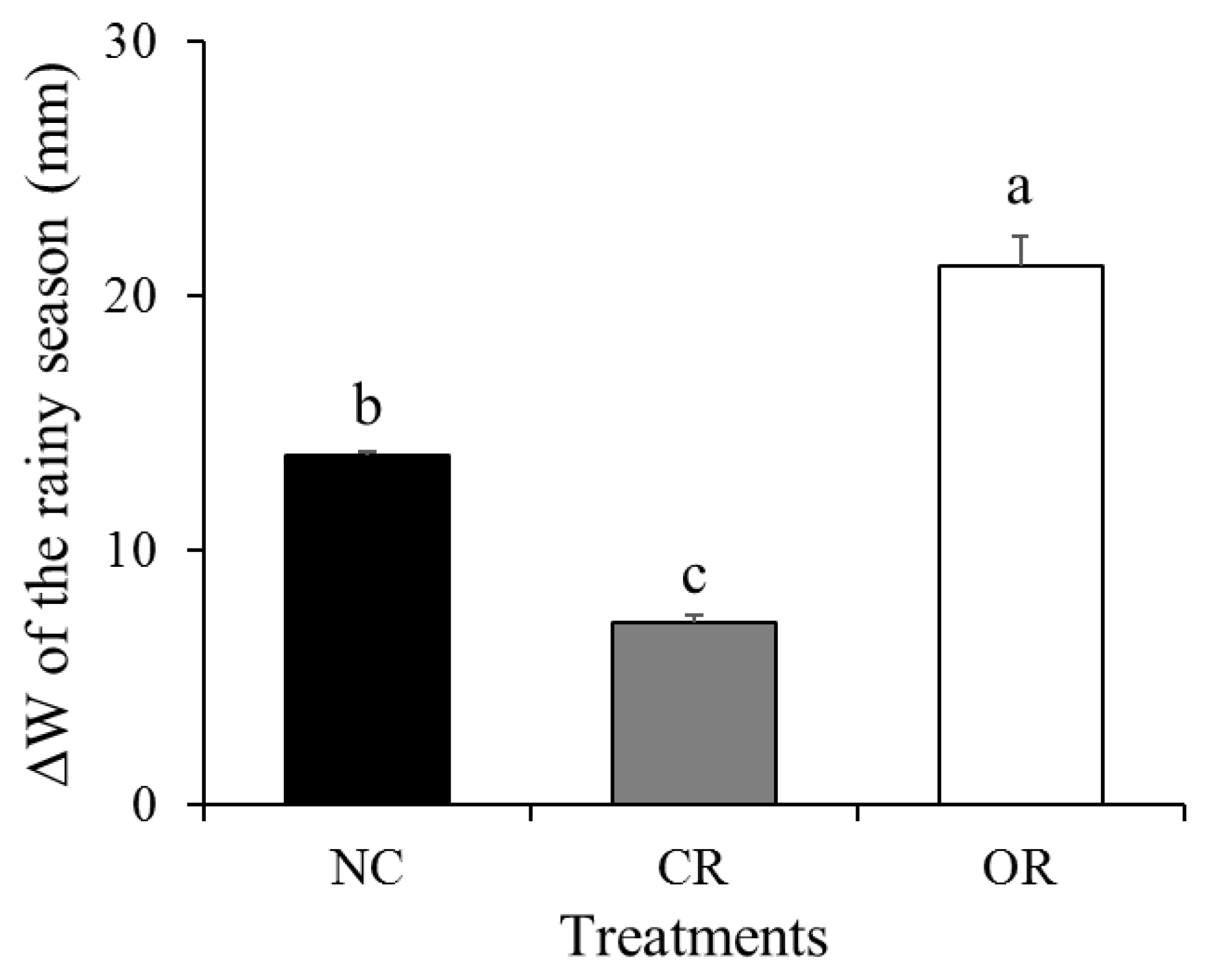Effect of Shrub Components on Soil Water and Its Response to Precipitation at Different Time Scales in the Loess Plateau
Abstract
1. Introduction
2. Materials and Methods
2.1. Study Area
2.2. Field Experiments
2.3. Data Analysis
3. Results
3.1. Dynamics of the Mean Soil Moisture (SMCm) at the Daily Scale
3.2. Dynamics of Daily SMC at Different Depths
3.3. The Relationships between W, ∆W, and Precipitation at the Daily Scale
3.4. Responses of ∆W to Precipitation on Rainy Days
3.5. The W and ∆W at the Monthly Scale
3.6. The Effect of Different Treatments on ∆W through the Whole Rainy Season
4. Discussion
4.1. Effects of Precipitation on Soil Water at Different Time Scales
4.2. Effects of Shrub Components on Soil Water Conservation
5. Conclusions
- (1)
- The response of the SMC to daily precipitation was gradually decreased and delayed for longer with an increase in soil depth. It was delayed by 0–2 days at a 10 cm depth, 5 days at a 20 cm depth, and 8 days or longer at a 40 cm depth.
- (2)
- A threshold phenomenon existed in the response of soil water to precipitation. Daily precipitation > 10 mm was the threshold to trigger a delayed response of the SMC below a 20 cm depth. The thresholds of precipitation to increase W were 2.09–2.54 mm at the daily scale and 29.40–32.56 mm at the monthly scale, respectively.
- (3)
- The contribution of precipitation to the soil water was 75–86% at the monthly scale, which was much larger than at the daily scale (45–58%).
- (4)
- Plant components showed significantly different influences on soil water. The roots could improve the soil water contents and strengthen its response to precipitation. The canopy consumed soil water, causing the smallest ∆W of the rainy season to be in the CR treatment and greatly weakening the influence of precipitation on soil water. The litter played a neutral role in the response of W to precipitation, decreasing W when daily precipitation was <10 mm and increasing W when daily precipitation was >10 mm.
Author Contributions
Funding
Institutional Review Board Statement
Informed Consent Statement
Data Availability Statement
Conflicts of Interest
References
- Boanares, D.; Oliveira, R.S.; Isaias, R.M.S.; Franca, M.G.C.; Penuelas, J. The Neglected Reverse Water Pathway: Atmosphere-Plant-Soil Continuum. Trends Plant Sci. 2020, 25, 1073–1075. [Google Scholar] [CrossRef] [PubMed]
- Fu, B.J.; Wang, S.; Liu, Y.; Liu, J.B.; Liang, W.; Miao, C.Y. Hydrogeomorphic Ecosystem Responses to Natural and Anthropogenic Changes in the Loess Plateau of China. Annu. Rev. Earth Planet. Sci. 2017, 45, 223–243. [Google Scholar] [CrossRef]
- Wang, S.; Fu, B.J.; Piao, S.L.; Lu, Y.H.; Ciais, P.; Feng, X.M.; Wang, Y.F. Reduced sediment transport in the Yellow River due to anthropogenic changes. Nat. Geosci. 2016, 9, 38–41. [Google Scholar] [CrossRef]
- Yu, Y.; Zhao, W.W.; Martinez-Murillo, J.F.; Pereira, P. Loess Plateau: From degradation to restoration. Sci. Total Environ. 2020, 738, 140206. [Google Scholar] [CrossRef] [PubMed]
- Zhu, R.; Yu, Y.; Zhao, J.; Liu, D.; Cai, S.; Feng, J.; Rodrigo-Comino, J. Evaluating the applicability of the water erosion prediction project (WEPP) model to runoff and soil loss of sandstone reliefs in the Loess Plateau, China. Int. Soil Water Conserv. Res. 2023, in press. [Google Scholar] [CrossRef]
- Wang, Y.Q.; Shao, M.A.; Zhu, Y.J.; Liu, Z.P. Impacts of land use and plant characteristics on dried soil layers in different climatic regions on the Loess Plateau of China. Agric. For. Meteorol. 2011, 151, 437–448. [Google Scholar] [CrossRef]
- Han, Y.P.; Xia, F.; Huang, H.P.; Mu, W.B.; Jia, D.D. Impact of the Grain for Green Project on water resources and ecological water stress in the Yanhe River Basin. PLoS ONE 2022, 17, e0259611. [Google Scholar] [CrossRef]
- Zhang, D.H.; Li, X.R.; Zhang, F.; Zhang, Z.S.; Chen, Y.L. Effects of rainfall intensity and intermittency on woody vegetation cover and deep soil moisture in dryland ecosystems. J. Hydrol. 2016, 543, 270–282. [Google Scholar] [CrossRef]
- Du, H.; Jiao, F.; Yao, J.; Li, D.; Fang, Z. Effects of Precipitation Changes on Soil Moisture Characteristics of Returning Farmland in Loess Hilly Region. Res. Soil Water Conserv. 2019, 26, 81–88. (In Chinese) [Google Scholar]
- Ge, F.C.; Xu, M.X.; Gong, C.; Zhang, Z.Y.; Tan, Q.Y.; Pan, X.H. Land cover changes the soil moisture response to rainfall on the Loess Plateau. Hydrol. Process. 2022, 36, 14714. [Google Scholar] [CrossRef]
- Zhao, L.S.; Meng, P.; Zhang, J.S.; Zhang, J.X.; Sun, S.J.; He, C.X. Effect of slopes on rainfall interception by leaf litter under simulated rainfall conditions. Hydrol. Process. 2022, 36, e14659. [Google Scholar] [CrossRef]
- Jin, Z.; Guo, L.; Lin, H.; Wang, Y.Q.; Yu, Y.L.; Chu, G.C.; Zhang, J. Soil moisture response to rainfall on the Chinese Loess Plateau after a long-term vegetation rehabilitation. Hydrol. Process. 2018, 32, 1738–1754. [Google Scholar] [CrossRef]
- Yu, Y.; Zhu, R.P.; Ma, D.M.; Liu, D.J.; Liu, Y.; Gao, Z.Q.; Yin, M.Q.; Bandala, E.R.; Rodrigo-Comino, J. Multiple surface runoff and soil loss responses by sandstone morphologies to land-use and precipitation regimes changes in the Loess Plateau, China. Catena 2022, 217, 106477. [Google Scholar] [CrossRef]
- Haiyan, D.A.I.; Haimei, W.A.N.G. Influence of rainfall events on soil moisture in a typical steppe of Xilingol. Phys. Chem. Earth 2021, 121, 102964. [Google Scholar] [CrossRef]
- Jia, J.B.; Yu, X.X.; Li, Y.T. Response of forestland soil water content to heavy rainfall on Beijing Mountain, northern China. J. For. Res. 2016, 27, 541–550. [Google Scholar] [CrossRef]
- Tanaka, K.; Hashimoto, S. Plant canopy effects on soil thermal and hydrological properties and soil respiration. Ecol. Model. 2006, 196, 32–44. [Google Scholar] [CrossRef]
- Allen, S.T.; Brooks, J.R.; Keim, R.F.; Bond, B.J.; McDonnell, J.J. The role of pre- event canopy storage in throughfall and stemflow by using isotopic tracers. Ecohydrology 2014, 7, 858–868. [Google Scholar] [CrossRef]
- Qiu, D.X.; Xu, R.R.; Wu, C.X.; Mu, X.M.; Zhao, G.J.; Gao, P. Effects of vegetation restoration on soil infiltrability and preferential flow in hilly gully areas of the Loess Plateau, China. Catena 2023, 221, 106770. [Google Scholar] [CrossRef]
- Liu, J.B.; Gao, G.Y.; Wang, S.; Jiao, L.; Wu, X.; Fu, B.J. The effects of vegetation on runoff and soil loss: Multidimensional structure analysis and scale characteristics. J. Geogr. Sci. 2018, 28, 59–78. [Google Scholar] [CrossRef]
- Xiong, Y.M.; Xia, H.X.; Li, Z.A.; Cai, X.A.; Fu, S.L. Impacts of litter and understory removal on soil properties in a subtropical Acacia mangium plantation in China. Plant Soil. 2008, 304, 179–188. [Google Scholar] [CrossRef]
- Wu, G.L.; Liu, Y.; Yang, Z.; Cui, Z.; Deng, L.; Chang, X.F.; Shi, Z.H. Root channels to indicate the increase in soil matrix water infiltration capacity of arid reclaimed mine soils. J. Hydrol. 2017, 546, 133–139. [Google Scholar] [CrossRef]
- Wang, H.F.; Zhu, X.A.; Zakari, S.; Chen, C.F.; Liu, W.J.; Jiang, X.J. Assessing the Effects of Plant Roots on Soil Water Infiltration Using Dyes and Hydrus-1D. Forests 2022, 13, 1095. [Google Scholar] [CrossRef]
- Wang, S.; Fu, B.; Gao, G.; Liu, Y.; Zhou, J. Responses of soil moisture in different land cover types to rainfall events in a re-vegetation catchment area of the Loess Plateau, China. Catena 2013, 101, 122–128. [Google Scholar] [CrossRef]
- Liu, J.B.; Liang, Y.; Gao, G.Y.; Dunkerley, D.; Fu, B.J. Quantifying the effects of rainfall intensity fluctuation on runoff and soil loss: From indicators to models. J. Hydrol. 2022, 607, 127494. [Google Scholar] [CrossRef]
- Fang, W.W.; Lu, N.; Liu, J.B.; Jiao, L.; Zhang, Y.; Wang, M.Y.; Fu, B.J. Canopy transpiration and stand water balance between two contrasting hydrological years in three typical shrub communities on the semiarid Loess Plateau of China. Ecohydrology 2019, 12, e2064. [Google Scholar] [CrossRef]
- Longobardi, A.; Khaertdinova, E. Relating soil moisture and air temperature to evapotranspiration fluxes during inter-storm periods at a Mediterranean experimental site. J. Arid. Land 2015, 7, 27–36. [Google Scholar] [CrossRef]
- Chen, Y.P.; Xia, J.B.; Zhao, X.M.; Zhuge, Y.P. Soil moisture ecological characteristics of typical shrub and grass vegetation on Shell Island in the Yellow River Delta, China. Geoderma 2019, 348, 45–53. [Google Scholar] [CrossRef]
- Cui, Z.; Wu, G.L.; Huang, Z.; Liu, Y. Fine roots determine soil infiltration potential than soil water content in semi-arid grassland soils. J. Hydrol. 2019, 578, 124023. [Google Scholar] [CrossRef]
- Ni, J.J.; Cheng, Y.F.; Wang, Q.H.; Ng, C.W.W.; Garg, A. Effects of vegetation on soil temperature and water content: Field monitoring and numerical modelling. J. Hydrol. 2019, 571, 494–502. [Google Scholar] [CrossRef]
- Liu, J.L.; Man, X.L. Characteristics of transpiration and evapo-transpiration from natural Larix gmelinii forests on rainy and non-rainy days. Acta Ecol. Sin. 2017, 37, 5059–5069. [Google Scholar] [CrossRef]
- Jiao, L.; Lu, N.; Fu, B.J.; Gao, G.Y.; Wang, S.; Jin, T.T.; Zhang, L.W.; Liu, J.B.; Zhang, D. Comparison of transpiration between different aged black locust (Robinia pseudoacacia) trees on the semi-arid Loess Plateau, China. J. Arid. Land 2016, 8, 604–617. [Google Scholar] [CrossRef]
- Ma, J.P.; Wang, X.; Zhao, X.N.; Tian, L.; Wang, Y.K. Experimental study of mulching effects on water restoration of deep, desiccated soil in a loess hilly region. Environ. Technol. 2022, 43, 3462–3472. [Google Scholar] [CrossRef] [PubMed]
- Luo, Z.T.; Niu, J.Z.; He, S.Q.; Zhang, L.; Chen, X.W.; Tan, B.; Wang, D.; Berndtsson, R. Linking roots, preferential flow, and soil moisture redistribution in deciduous and coniferous forest soils. J. Soil Sediments 2022, 23, 1524–1538. [Google Scholar] [CrossRef]
- Hipps, N.A.; Davies, M.J.; Dunn, J.M.; Griffiths, H.; Atkinson, C.J. Effects of two contrasting canopy manipulations on growth and water use of London plane (Platanus x acerifolia) trees. Plant Soil 2014, 382, 61–74. [Google Scholar] [CrossRef]
- Zhang, X.; Yu, G.Q.; Li, Z.B.; Li, P. Experimental Study on Slope Runoff, Erosion and Sediment under Different Vegetation Types. Water Resour. Manag. 2014, 28, 2415–2433. [Google Scholar] [CrossRef]
- Cao, R.X.; Pei, Y.W.; Jia, X.X.; Huang, L.M. Rapid soil water recovery after conversion of introduced peashrub and alfalfa to natural grassland on northern China’s Loess Plateau. Can. J. Soil. Sci. 2020, 100, 302–313. [Google Scholar] [CrossRef]
- Xu, L.H.; Cao, G.X.; Wang, Y.N.; Hao, J.; Wang, Y.H.; Yu, P.T.; Liu, Z.B.; Xiong, W.; Wang, X. Components of stand water balance of a larch plantation after thinning during the extremely wet and dry years in the Loess Plateau, China. Glob. Ecol. Conserv. 2020, 24, e01307. [Google Scholar] [CrossRef]










| Indicators | Soil Depths (cm) | NC | CR | OR |
|---|---|---|---|---|
| W | 5 | 0.161 | −0.018 | −0.028 |
| 10 | −0.047 | −0.046 | −0.054 | |
| 20 | −0.255 ** | −0.226 * | −0.182 | |
| 40 | −0.216 * | −0.182 | −0.223 * | |
| Total (0–40) | −0.043 | −0.125 | −0.167 | |
| ∆W | 5 | 0.477 ** | 0.301 ** | 0.311 ** |
| 10 | 0.403 ** | 0.298 ** | 0.391 ** | |
| 20 | −0.162 | −0.054 | −0.048 | |
| 40 | 0.239 * | 0.238 ** | 0.325 ** | |
| Total (0–40) | 0.504 ** | 0.419 ** | 0.384 ** |
Disclaimer/Publisher’s Note: The statements, opinions and data contained in all publications are solely those of the individual author(s) and contributor(s) and not of MDPI and/or the editor(s). MDPI and/or the editor(s) disclaim responsibility for any injury to people or property resulting from any ideas, methods, instructions or products referred to in the content. |
© 2023 by the authors. Licensee MDPI, Basel, Switzerland. This article is an open access article distributed under the terms and conditions of the Creative Commons Attribution (CC BY) license (https://creativecommons.org/licenses/by/4.0/).
Share and Cite
Liu, J.; Gao, G.; Zhang, B. Effect of Shrub Components on Soil Water and Its Response to Precipitation at Different Time Scales in the Loess Plateau. Int. J. Environ. Res. Public Health 2023, 20, 4722. https://doi.org/10.3390/ijerph20064722
Liu J, Gao G, Zhang B. Effect of Shrub Components on Soil Water and Its Response to Precipitation at Different Time Scales in the Loess Plateau. International Journal of Environmental Research and Public Health. 2023; 20(6):4722. https://doi.org/10.3390/ijerph20064722
Chicago/Turabian StyleLiu, Jianbo, Guangyao Gao, and Bing Zhang. 2023. "Effect of Shrub Components on Soil Water and Its Response to Precipitation at Different Time Scales in the Loess Plateau" International Journal of Environmental Research and Public Health 20, no. 6: 4722. https://doi.org/10.3390/ijerph20064722
APA StyleLiu, J., Gao, G., & Zhang, B. (2023). Effect of Shrub Components on Soil Water and Its Response to Precipitation at Different Time Scales in the Loess Plateau. International Journal of Environmental Research and Public Health, 20(6), 4722. https://doi.org/10.3390/ijerph20064722







